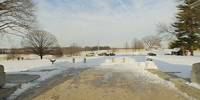
National Memorial Arch
Valley Forge National Historic Park, Pennsylvania, USA
December 10, 2005, 2:37 PM
© 2005 Carlton SooHoo, All Rights Reserved.
From the Valley Forge Historical Society: Originally, in 1908, Congressman Irving P. Wanger of Norristown introduced a bill to Congress for federal funds for two arches at Valley Forge to honor 1-Washington and 2-Von Steuben. After much debate, the bill was amended to reduce the number to one arch to honor Washington. It was approved in Congress in 1910 and at that point they resolved that the secretary of war would oversee the project.
The designer of the architect was Paul Philippe Cret — a professor at the University of Pennsylvania. Cret was from France and studied at the Ecole des Beaux Arts. [Some of his Philadelphia structures include the Rodin Museum, the Federal Reserve Bank building and the Ben Franklin Bridge to name just a few].
The final design inspiration came from the Arch of Titus in Rome. It became controversial in some part for the fact that some people didn't want to see a triumphal arch in a rural setting. (Roman arches were always part of an urban setting). Some controversy also came up over its location, but it remained in its planned location.
The National Memorial Arch was dedicated June 19, 1917. The dedication ceremony was attended by a number of US Congressmen and hundreds of visitors. The formal address of dedication was given by then Pennsylvania governor, Martin Brumbaugh. The thought of patriotism at that time was VERY strong due to the fact the world was in chaos over WWI.
The Arch underwent an extensive renovation project the last couple of years — with funds donated by the Masons. It was rededicated with a special ceremony in 1997.
I took four shots at 90 degrees each, and one shot straight upward.
Exposure was: ISO 100, f/8, 1/180 sec. Raw image recorded.
Henry Armitt Brown
------------------------------
Commander in Chief: George Washington
Major Generals: DeKalb, Greene, Lafayette, Lee, Mifflin, Steuben, Stirling, Sullivan
Brigadier Generals: Armstrong, DuPortail, Glover, Huntington, Knox, Learned, McIntosh, Maxwell, Muhlenberg, Patterson, Poor, Scott, Smallwood, Varnum, Wayne, Weedon, Woodford, Pulaski


 Tap or click the zoom icon in the bottom right corner of the picture to switch between in-page and fullscreen view
Tap or click the zoom icon in the bottom right corner of the picture to switch between in-page and fullscreen view